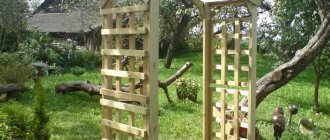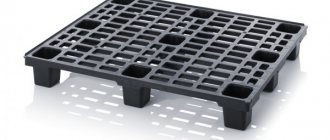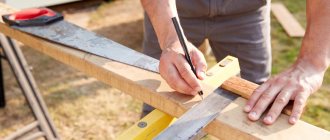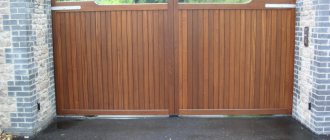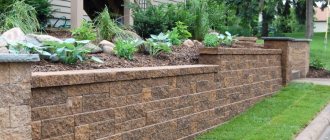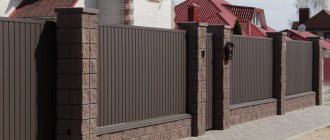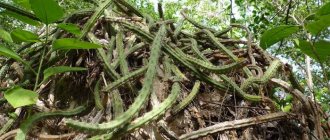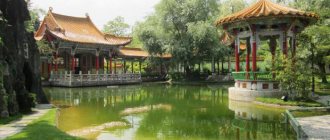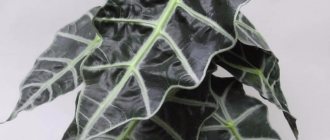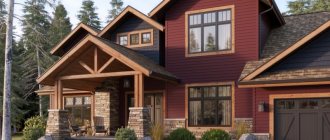07/04/2019 Author: VT-METALL
Issues discussed in the material:
- What types of metal fences are there for areas?
- What are the types of metal railings for balconies and stairs?
- What are the features of barrier metal fencing
Metal fencing is the optimal solution when choosing a fence. They meet construction requirements, are reliable, easy to use, and quite durable. Next, we will consider in detail the different types of metal fences.
Purpose and advantages of temporary fencing
Accordingly, the main purpose of fencing is:
- Restricting access to potentially dangerous territory by strangers.
- Preservation of property and materials.
- Protection of the external area from construction debris.
There is also an unexpected use of construction fencing - it was installed here to prevent the road from being covered with snow. Source kitairu.net
The type of temporary fence is selected taking into account the characteristics of its further operation. Regardless of the design and temporary nature of use, such construction fencing has a number of advantages:
- Mobility. Such fences are easy to install and dismantle due to their light weight and well-thought-out design.
- Durability and long service life.
- Reusable.
- Price. Significantly less than stationary analogues (the foundation is not built).
Temporary fencing to isolate an emergency area - a budget solution to the problem Source skopelitissa.com
Mobile structures
Temporary fencing of this type appeared relatively recently. They, like other structures, provide protection for citizens from accidents, security of the facility, and prevent unauthorized entry of strangers. Metal mobile elements are also used to delimit parking spaces and mark the perimeter of a site. Installation does not require special equipment or special knowledge. Installation of elements is carried out in a short time. Panel sections are equipped with special fastenings. They eliminate unwanted or accidental dismantling.
Basic requirements for temporary fencing
A construction fence allows you to quickly mark the boundaries of the site; installation is permitted if the design is made in accordance with the following standards:
- The height of security fences (including fences with a canopy) is 2 m; standard protective fences (without canopy) - 1.6 m, fencing for work sites - 1.2 m.
- Protective canopies are made with an elevation of 20° to the road.
- The length of spans (rectangular sections) is limited to 1.2, 1.6 or 2 meters.
- For pedestrians, a strip 1.2-1.5 m wide is allocated on the outside of the fence.
- There are gates (sufficient for construction equipment to pass through) and a wicket gate. The safety margin of the fence is monitored throughout its service life; it must withstand wind and precipitation.
A temporary fence in the form of a metal structure with a canopy Source vseozabore.ru
A design that does not meet the requirements can itself become a source of danger. There have been cases of falling of an insufficiently secured construction fence. It happened that a strong gust of wind tore off a weakly fixed section. The structural elements injured nearby passers-by and damaged passing cars. The damage caused was sometimes significant - the weight of a linear meter of a metal profile fence amounts to tens of kilograms. Responsibility for an emergency falls on the construction organization that installed the fence.
See also: Catalog of companies that specialize in the construction of fences and enclosures.
Conclusion
We figured out what you can use to make a reliable, durable fence.
In “Metal Profile” you will find different options for materials for the fence: corrugated sheeting, metal siding, steel picket fence. They are distinguished by their long service life, aesthetics, environmental friendliness, durability, and lack of operating costs.
Which fence material is best? It all depends on your preferences.
- The most inexpensive is low-wave corrugated sheeting.
- The most aesthetically pleasing are picket fences and metal siding.
- The most rare type is steel siding.
- The easiest to install is corrugated sheeting.
- The most suitable option for areas with strong winds is a picket fence.
Choose what is best to make a fence from and order the optimal material from our catalog!
* Detailed information about warranty periods for products can be obtained on the website metallprofil.ru in the “Documents” section.
** In Metal Profile sales offices in the cities of Verkhnyaya Pyshma, Yekaterinburg, Izhevsk, Kurgan, Magnitogorsk, Perm, Surgut, Tyumen, Ufa, Chelyabinsk, Abakan, Barnaul, Belovo, Biysk, Irkutsk, Kemerovo, Krasnoyarsk, Mayma, Novokuznetsk, Novosibirsk, Omsk, Tomsk, Ulan-Ude, Shelekhov and in the village of Keramkombinat.
The categories mentioned in the article are:
Metal picket fence
Profiled sheet
Metal siding
Types and features of temporary fencing at a construction site:
In modern construction conditions, the advantage belongs to lightweight, mobile, reusable structures. Many materials have such properties, including various versions of metal fences. Temporary fencing for construction sites is classified in several ways:
By design
- Panel (both solid and sparse, for example, mesh fabric are used).
- Post fencing.
- Combined fencing options.
Fencing structure with protection for pedestrians Source lestorg32.ru
Fences are equipped with additional elements; as necessary, these can be struts, struts, canopies, railings, sidewalks.
By functional purpose
- Signal (emergency) The fenced area is highlighted visually (for example, with a bright mesh). Design markings begin with the number 1.
- Protective. Protection of others from injury (the mesh covering the façade limits the spread of waste and stops tools that have slipped from the scaffolding). The marking starts with the number 2.
- Protective-signal (security). Protecting the territory from unauthorized persons. They are found both at construction sites and at manufacturing enterprises; they are only solid. The marking starts with the number 3.
Safe work with facade mesh Source derevyannyy.com
What it is?
Temporary fencing at a construction site is an engineering structure made of various materials to mark the boundaries of the site where construction and installation work is being carried out. It is mandatory to install, regardless of the duration and scale of construction.
A barrier structure to protect an object from unauthorized persons consists of supports, a frame, and filling. It is durable, easy to assemble and disassemble, and can be reused on another site.
Why is there a fence on the site?
Article 52 of the Town Planning Code of the Russian Federation establishes the obligation of the person carrying out construction to ensure safety for people, animals and the environment.
Code of Practice 48.13330.2019 obliges developers to install temporary fences before the start of construction.
As a rule, the absence of a fence or its non-functionality is identified by construction supervision along with other inconsistencies. A violation becomes the basis for bringing to administrative liability - under Part 1 or Part 2 of Art. 9.4 Code of Administrative Offenses of the Russian Federation.
If the lack of a continuous fence caused death or an accident, caused harm to animals and plants, or caused damage to property, Part 2 of Art. 9.4 Code of Administrative Offenses of the Russian Federation.
Part 1. Art. 9.4 Code of Administrative Offenses of the Russian Federation :
- fine for officials - 20-30 thousand rubles;
- for legal entities – 100-300 thousand.
Part 2 art. 9.4 Code of Administrative Offenses of the Russian Federation :
- fine for officials – 30-35 thousand rubles,
- for legal entities – 300-600 thousand or suspension of activities for 60 days.
When is it needed and is it possible to get by?
Fencing of the area allocated for construction is carried out before the start of construction and installation work. A temporary fence prevents strangers from entering the danger zone and provides :
- safety precautions at a construction site;
- preservation of life and health for passers-by: protection from the possibility of heavy objects, tools, structures falling from a height (when they are moved by a crane);
- safety of structures, mechanisms, equipment, materials from damage and theft.
There are many hazardous production factors on a construction site, so such areas are separated by protective fences. High-risk areas include :
- building site;
- the floor of the building above which the equipment is installed or dismantled;
- areas of movement of transport and construction workers;
- crane operating areas.
Areas with the constant presence of hazardous factors are marked with protective fences, and areas with the potential impact of these factors are marked with signal fences.
The developer cannot do without fencing the construction site - liability for this violation is described in the section above.
The only exception to the rules is the impossibility or economic infeasibility of installing protective barriers for specialists working at heights. In this case, builders use safety belts and issue a work permit.
Some common signal-type fences
1A N(1) and 1A N(2)
Both types of fencing consist of frames of the same size (length 2000, width 2000 (or 2400) mm). They are installed on a supporting concrete block (length 600, width 250, height 150 mm). The frame is welded from rolled profiles.
The difference is the material filling the frame. For fencing 1A N(1) it is a metal sheet with fine perforation; 1A N(2) – perforated metal siding. The use of different materials determines the difference in price. The average cost of 1A N(1) starts from 3600 rub./rm, 1A N(2) – 4200 rub./rm.
Another type of fencing is signal fencing, type 1A Source docplayer.ru
Installation procedure
Installation of the fence (with concreting the pillars) consists of the following sequential steps:
- The perimeter is marked, marker posts are installed, and a rope is pulled to mark the top of the fence.
- After 2.5 m, holes are made for supports.
- A section of 2 pillars and a panel is assembled on the ground.
- The section is installed vertically (along the rope and level), the pillars in the holes are concreted, the section is secured with supports.
- The second panel is being installed.
- The next pillar is concreted and so on until the fence is completed.
You can clearly see the entire work process in the following video:
Classification by material
Any material can be used as a fence if it meets the requirements. Builders have already developed certain preferences, and the material is selected depending on the proximity of the object under construction and the budget allocated for the fencing.
Plastic temporary fence for construction
This polymer product is a convenient option for many reasons:
- low cost;
- simple installation (without involving a work crew or special equipment) and further maintenance;
- noticeable from afar;
- strength and resistance to weather conditions (temperature changes, rotting, corrosion) means a long service life.
Temporary fences made of corrugated sheets
Such products (together with welded mesh panels) are more common than other metal fences. Profiled sheets are mounted on supports with a supporting frame. Peculiarities:
- average price and easy assembly;
- light, durable and reusable.
Corrugated sheet - protection from prying eyes and temporary fencing of a construction site Source megastrolis.ru
Temporary wooden fences
A wooden construction site fence is often needed in the city; In conditions of narrow sidewalks and heavily congested streets, a reliable design with a visor is welcome.
Such a fence can be reused, especially if the wood was impregnated with a protective compound before use. Peculiarities:
- easy to assemble and disassemble;
- the best material for creating structures with sidewalks and canopies for repeated use (can be moved along the perimeter);
- the use of second-grade wood is allowed;
- has sufficient rigidity;
- requires protection from dampness and bugs.
Concrete plates
They are used less and less for fencing work sites. They are needed if large-scale dangerous construction is planned (dam, bridge, metro tunnel). Peculiarities:
- high cost;
- installed using special equipment;
- dampen the noise of construction mechanisms;
- suitable for long-term projects, reusable;
- unreliable protection against penetration (easy to climb over).
Panel concrete protection Source mytashkent.uz
Slate fencing
Such fences are not used often due to the heavy weight and fragility of the material. The list of advantages includes a budget price, fire safety and easy installation. In addition, slate is not afraid of rain and ultraviolet radiation.
Chainlink fences
The mesh is a universal design that can be quickly and easily mounted on a frame made of profile pipes or a corner. It is valued for its reusability, ease of movement and low cost.
The Truth of Hedge Care
Despite the obvious advantages, it is necessary to understand that fences must be maintained, as this directly affects their service life. The main problem is rust, which begins to appear on metal products over time.
Rust is a natural process that occurs when metal comes into contact with moisture during rain, snow, fog, etc. The protective layer of metal products is vulnerable to temperature changes. Over time, the metal becomes exposed, which causes rust.
In the same way, minor scratches on a metal fence can not only ruin the appearance, but also lead to corrosion. To avoid this, you only need to promptly treat the surface with anti-corrosion agents, as well as renew the coating in areas that have already begun to rust. Experts advise covering metal fences with new paint at least once every three years.
Metal fences are a smart choice for modern people. Thanks to new technologies, everyone will be able to turn ideas for fencing their home, cottage, garage and any other property into reality.
Installation sequence
The construction fence is installed according to the classic fence algorithm:
- First stage. A diagram is drawn up and the length and type of fence is determined.
- Preparing the area. The perimeter of the construction site is cleared and leveled.
- Installation. If the territory will be fenced for a long time (a year or more), they will not install temporary portable fences, but permanent ones. The supports are not concreted, but fixed in the ground. Installation will be completed quickly if the area is surrounded by a fence made of corrugated sheets (or welded mesh).
Review of options for a suburban area
A fence made of corrugated sheets can last for decades. To manufacture it, it is necessary to take into account the design, installation method, and cost. Today, a variety of types of fencing allows you to choose the appropriate type for your site. It is easy to fit harmoniously into any façade. For example, for a minimalist or high-tech style, you can build a transparent fence with alternating vertical and horizontal stripes. Although the site cannot be hidden from the eyes of strangers, the general style of the buildings will be preserved intact.
To decorate a wooden house, a chain-link mesh or picket fence is suitable. The main thing is that the surface looks like wood.
Homes with luxurious designs need to be framed with a decent fence. It can be made from forged elements, which are distinguished by their decorative effect.
The Gothic style is well complemented by forged fences, emphasized by pointed peaks. The facade, made in a classic style, is surrounded by a simple metal fence. But forged elements or metal siding will also go well with such buildings.
How to choose a quality fence: tips and nuances
High-quality fencing of the construction area is an absolutely necessary condition for starting construction. Construction fencing - fences made of any materials, are selected depending on the following characteristics and parameters:
- Locations of construction work (busy city center, residential area, suburbs, rural areas).
- Parameters of the object (private or multi-storey building, stadium, school, shopping center).
- External conditions (features of the site, timing of work, presence of traffic outside the construction perimeter).
- Features of the work (reconstruction, construction from scratch, restoration).
- Estimates.
As a rule, builders prefer a solid fence made of corrugated sheets. To make the structure resistant to wind, it is weighted using concrete and PVC blocks or secured in the ground with reinforcing pins. If the fence runs close to utility networks, it is erected on foundation blocks.
Areas of use
Various types of perimeter fencing are great for defining the boundary, framing, protecting and securing a variety of objects:
- restricted areas;
- important areas of oil and gas complexes;
- substation territories;
- any production sites;
- territories during construction (repair) of buildings, roads and structures;
- gas station;
- airports;
- railway lines;
- highways;
- urban areas;
- parking;
- private estates and country houses;
- summer cottages;
- agricultural areas;
- zoos and enclosures;
- military bases;
- airports.
Read this article for what protective barriers in hazardous areas are used for.
You will find the types and stages of installation of fencing for sports fields here.
Average prices for some types of fencing
- Portable fencing economy (painted or primed) – 800-1200-1500 rubles.
- Inventory fencing made of 3D welded steel, depending on size, – 1500-2600-3500 rubles.
- Reinforced fencing ROUND – 4000-4200-4400 rub./rm
- Blind (made of galvanized corrugated sheeting) – from 4000 rub./rm
- Facade protective mesh for scaffolding – from 8 rubles/m², from 4500 rubles/roll (100 m).
Fence on a New York street Source pinterest.com
Budgeting
The estimate for a temporary fence of a construction site, depending on the design, includes the costs of work and materials :
site preparation;- drilling holes (equipment, type of soil);
- concreting supports;
- operation of equipment (vibrator, mobile bitumen boilers, welding installations, electric drills, planes, saws,
- automotive equipment, excavators, cranes;
- hardware materials: bolts, nails, screws;
- timber: boards, bars;
- antiseptic paste;
- galvanized corrugated sheeting;
- installation of swing gates, wickets;
- concrete, cement mortar, resin for road construction.
The estimate is drawn up for a specific fence. An example can be downloaded here.
Psychological impact
All their lives people have strived for specificity in the designation of space: designation of the boundaries of permitted interference in personal space for others regarding each person or regarding the entire state (maps with boundaries) and such buildings as the Great Wall of China. To feel comfortable while on the territory, a person needs to feel the limits of the space, its size. In this case, he will feel a sense of security. If you have been to large parks or forests, where the boundaries of the territory are not visible, then you probably experienced a feeling of spaciousness and infinity, but it is unlikely that you will feel the same security as in your home. Therefore, the fence creates a sense of privacy, helping to feel like a master in your own small but very significant world.
Feeling of security, comfort and coziness of your own private space
